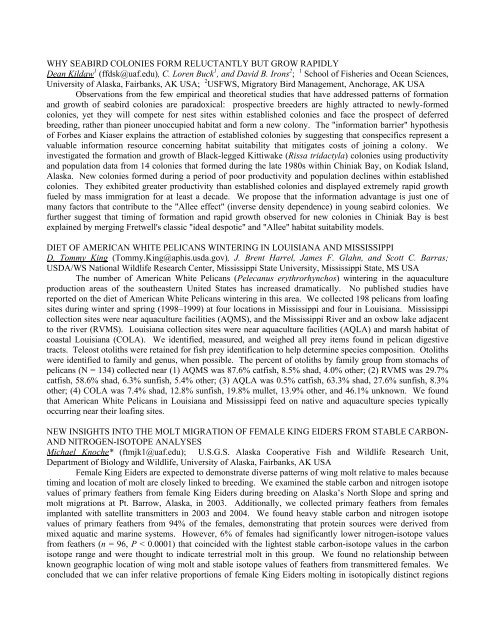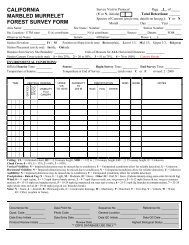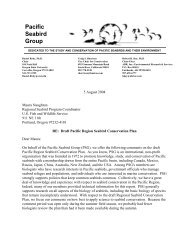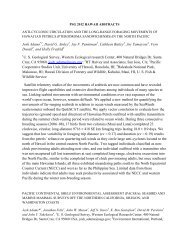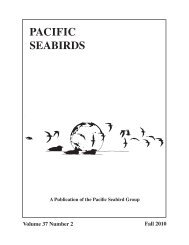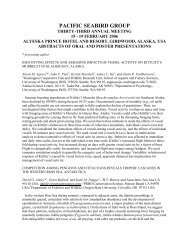abstracts of oral and poster presentations - Pacific Seabird Group
abstracts of oral and poster presentations - Pacific Seabird Group
abstracts of oral and poster presentations - Pacific Seabird Group
Create successful ePaper yourself
Turn your PDF publications into a flip-book with our unique Google optimized e-Paper software.
WHY SEABIRD COLONIES FORM RELUCTANTLY BUT GROW RAPIDLY<br />
Dean Kildaw 1 (ffdsk@uaf.edu), C. Loren Buck 1 , <strong>and</strong> David B. Irons 2 ; 1 School <strong>of</strong> Fisheries <strong>and</strong> Ocean Sciences,<br />
University <strong>of</strong> Alaska, Fairbanks, AK USA; 2 USFWS, Migratory Bird Management, Anchorage, AK USA<br />
Observations from the few empirical <strong>and</strong> theoretical studies that have addressed patterns <strong>of</strong> formation<br />
<strong>and</strong> growth <strong>of</strong> seabird colonies are paradoxical: prospective breeders are highly attracted to newly-formed<br />
colonies, yet they will compete for nest sites within established colonies <strong>and</strong> face the prospect <strong>of</strong> deferred<br />
breeding, rather than pioneer unoccupied habitat <strong>and</strong> form a new colony. The "information barrier" hypothesis<br />
<strong>of</strong> Forbes <strong>and</strong> Kiaser explains the attraction <strong>of</strong> established colonies by suggesting that conspecifics represent a<br />
valuable information resource concerning habitat suitability that mitigates costs <strong>of</strong> joining a colony. We<br />
investigated the formation <strong>and</strong> growth <strong>of</strong> Black-legged Kittiwake (Rissa tridactyla) colonies using productivity<br />
<strong>and</strong> population data from 14 colonies that formed during the late 1980s within Chiniak Bay, on Kodiak Isl<strong>and</strong>,<br />
Alaska. New colonies formed during a period <strong>of</strong> poor productivity <strong>and</strong> population declines within established<br />
colonies. They exhibited greater productivity than established colonies <strong>and</strong> displayed extremely rapid growth<br />
fueled by mass immigration for at least a decade. We propose that the information advantage is just one <strong>of</strong><br />
many factors that contribute to the "Allee effect" (inverse density dependence) in young seabird colonies. We<br />
further suggest that timing <strong>of</strong> formation <strong>and</strong> rapid growth observed for new colonies in Chiniak Bay is best<br />
explained by merging Fretwell's classic "ideal despotic" <strong>and</strong> "Allee" habitat suitability models.<br />
DIET OF AMERICAN WHITE PELICANS WINTERING IN LOUISIANA AND MISSISSIPPI<br />
D. Tommy King (Tommy.King@aphis.usda.gov), J. Brent Harrel, James F. Glahn, <strong>and</strong> Scott C. Barras;<br />
USDA/WS National Wildlife Research Center, Mississippi State University, Mississippi State, MS USA<br />
The number <strong>of</strong> American White Pelicans (Pelecanus erythrorhynchos) wintering in the aquaculture<br />
production areas <strong>of</strong> the southeastern United States has increased dramatically. No published studies have<br />
reported on the diet <strong>of</strong> American White Pelicans wintering in this area. We collected 198 pelicans from loafing<br />
sites during winter <strong>and</strong> spring (1998–1999) at four locations in Mississippi <strong>and</strong> four in Louisiana. Mississippi<br />
collection sites were near aquaculture facilities (AQMS), <strong>and</strong> the Mississippi River <strong>and</strong> an oxbow lake adjacent<br />
to the river (RVMS). Louisiana collection sites were near aquaculture facilities (AQLA) <strong>and</strong> marsh habitat <strong>of</strong><br />
coastal Louisiana (COLA). We identified, measured, <strong>and</strong> weighed all prey items found in pelican digestive<br />
tracts. Teleost otoliths were retained for fish prey identification to help determine species composition. Otoliths<br />
were identified to family <strong>and</strong> genus, when possible. The percent <strong>of</strong> otoliths by family group from stomachs <strong>of</strong><br />
pelicans (N = 134) collected near (1) AQMS was 87.6% catfish, 8.5% shad, 4.0% other; (2) RVMS was 29.7%<br />
catfish, 58.6% shad, 6.3% sunfish, 5.4% other; (3) AQLA was 0.5% catfish, 63.3% shad, 27.6% sunfish, 8.3%<br />
other; (4) COLA was 7.4% shad, 12.8% sunfish, 19.8% mullet, 13.9% other, <strong>and</strong> 46.1% unknown. We found<br />
that American White Pelicans in Louisiana <strong>and</strong> Mississippi feed on native <strong>and</strong> aquaculture species typically<br />
occurring near their loafing sites.<br />
NEW INSIGHTS INTO THE MOLT MIGRATION OF FEMALE KING EIDERS FROM STABLE CARBON-<br />
AND NITROGEN-ISOTOPE ANALYSES<br />
Michael Knoche* (ftmjk1@uaf.edu); U.S.G.S. Alaska Cooperative Fish <strong>and</strong> Wildlife Research Unit,<br />
Department <strong>of</strong> Biology <strong>and</strong> Wildlife, University <strong>of</strong> Alaska, Fairbanks, AK USA<br />
Female King Eiders are expected to demonstrate diverse patterns <strong>of</strong> wing molt relative to males because<br />
timing <strong>and</strong> location <strong>of</strong> molt are closely linked to breeding. We examined the stable carbon <strong>and</strong> nitrogen isotope<br />
values <strong>of</strong> primary feathers from female King Eiders during breeding on Alaska’s North Slope <strong>and</strong> spring <strong>and</strong><br />
molt migrations at Pt. Barrow, Alaska, in 2003. Additionally, we collected primary feathers from females<br />
implanted with satellite transmitters in 2003 <strong>and</strong> 2004. We found heavy stable carbon <strong>and</strong> nitrogen isotope<br />
values <strong>of</strong> primary feathers from 94% <strong>of</strong> the females, demonstrating that protein sources were derived from<br />
mixed aquatic <strong>and</strong> marine systems. However, 6% <strong>of</strong> females had significantly lower nitrogen-isotope values<br />
from feathers (n = 96, P < 0.0001) that coincided with the lightest stable carbon-isotope values in the carbon<br />
isotope range <strong>and</strong> were thought to indicate terrestrial molt in this group. We found no relationship between<br />
known geographic location <strong>of</strong> wing molt <strong>and</strong> stable isotope values <strong>of</strong> feathers from transmittered females. We<br />
concluded that we can infer relative proportions <strong>of</strong> female King Eiders molting in isotopically distinct regions


